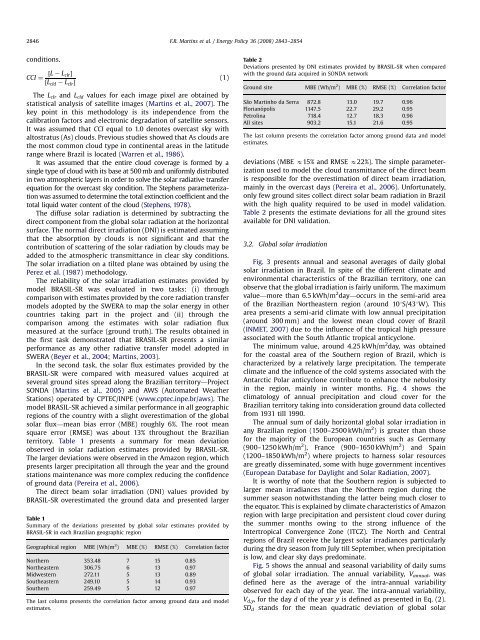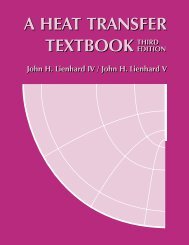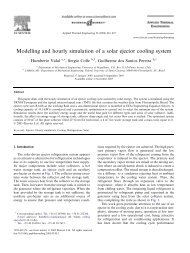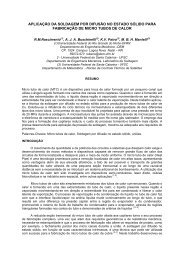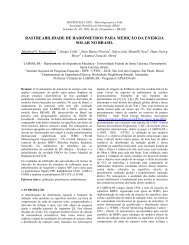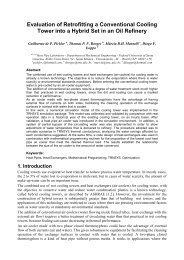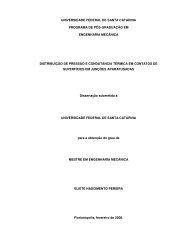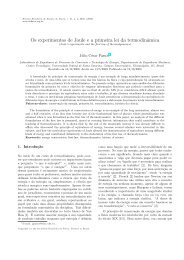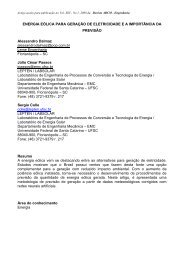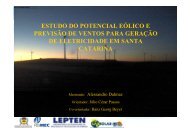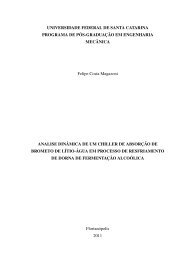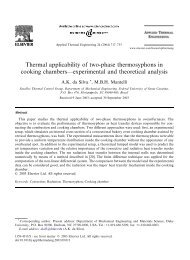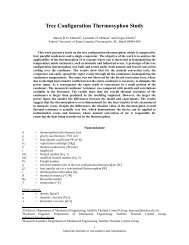Solar energy scenarios in Brazil, Part one: Resource ... - LEPTEN
Solar energy scenarios in Brazil, Part one: Resource ... - LEPTEN
Solar energy scenarios in Brazil, Part one: Resource ... - LEPTEN
You also want an ePaper? Increase the reach of your titles
YUMPU automatically turns print PDFs into web optimized ePapers that Google loves.
ARTICLE IN PRESS2846F.R. Mart<strong>in</strong>s et al. / Energy Policy 36 (2008) 2843–2854conditions.CCI ¼ ½L L clrŠ(1)½L cld L clr ŠThe L clr and L cld values for each image pixel are obta<strong>in</strong>ed bystatistical analysis of satellite images (Mart<strong>in</strong>s et al., 2007). Thekey po<strong>in</strong>t <strong>in</strong> this methodology is its <strong>in</strong>dependence from thecalibration factors and electronic degradation of satellite sensors.It was assumed that CCI equal to 1.0 denotes overcast sky withaltostratus (As) clouds. Previous studies showed that As clouds arethe most common cloud type <strong>in</strong> cont<strong>in</strong>ental areas <strong>in</strong> the latituderange where <strong>Brazil</strong> is located (Warren et al., 1986).It was assumed that the entire cloud coverage is formed by as<strong>in</strong>gle type of cloud with its base at 500 mb and uniformly distributed<strong>in</strong> two atmospheric layers <strong>in</strong> order to solve the solar radiative transferequation for the overcast sky condition. The Stephens parameterizationwas assumed to determ<strong>in</strong>e the total ext<strong>in</strong>ction coefficient and thetotal liquid water content of the cloud (Stephens, 1978).The diffuse solar radiation is determ<strong>in</strong>ed by subtract<strong>in</strong>g thedirect comp<strong>one</strong>nt from the global solar radiation at the horizontalsurface. The normal direct irradiation (DNI) is estimated assum<strong>in</strong>gthat the absorption by clouds is not significant and that thecontribution of scatter<strong>in</strong>g of the solar radiation by clouds may beadded to the atmospheric transmittance <strong>in</strong> clear sky conditions.The solar irradiation on a tilted plane was obta<strong>in</strong>ed by us<strong>in</strong>g thePerez et al. (1987) methodology.The reliability of the solar irradiation estimates provided bymodel BRASIL-SR was evaluated <strong>in</strong> two tasks: (i) throughcomparison with estimates provided by the core radiation transfermodels adopted by the SWERA to map the solar <strong>energy</strong> <strong>in</strong> othercountries tak<strong>in</strong>g part <strong>in</strong> the project and (ii) through thecomparison among the estimates with solar radiation fluxmeasured at the surface (ground truth). The results obta<strong>in</strong>ed <strong>in</strong>the first task demonstrated that BRASIL-SR presents a similarperformance as any other radiative transfer model adopted <strong>in</strong>SWERA (Beyer et al., 2004; Mart<strong>in</strong>s, 2003).In the second task, the solar flux estimates provided by theBRASIL-SR were compared with measured values acquired atseveral ground sites spread along the <strong>Brazil</strong>ian territory—ProjectSONDA (Mart<strong>in</strong>s et al., 2005) and AWS (Automated WeatherStations) operated by CPTEC/INPE (www.cptec.<strong>in</strong>pe.br/aws). Themodel BRASIL-SR achieved a similar performance <strong>in</strong> all geographicregions of the country with a slight overestimation of the globalsolar flux—mean bias error (MBE) roughly 6%. The root meansquare error (RMSE) was about 13% throughout the <strong>Brazil</strong>ianterritory. Table 1 presents a summary for mean deviationobserved <strong>in</strong> solar radiation estimates provided by BRASIL-SR.The larger deviations were observed <strong>in</strong> the Amazon region, whichpresents larger precipitation all through the year and the groundstations ma<strong>in</strong>tenance was more complex reduc<strong>in</strong>g the confidenceof ground data (Pereira et al., 2006).The direct beam solar irradiation (DNI) values provided byBRASIL-SR overestimated the ground data and presented largerTable 1Summary of the deviations presented by global solar estimates provided byBRASIL-SR <strong>in</strong> each <strong>Brazil</strong>ian geographic regionGeographical region MBE (Wh/m 2 ) MBE (%) RMSE (%) Correlation factorNorthern 353.48 7 15 0.85Northeastern 306.75 6 13 0.97Midwestern 272.11 5 13 0.89Southeastern 249.10 5 14 0.93Southern 259.49 5 12 0.97The last column presents the correlation factor among ground data and modelestimates.Table 2Deviations presented by DNI estimates provided by BRASIL-SR when comparedwith the ground data acquired <strong>in</strong> SONDA networkGround site MBE (Wh/m 2 ) MBE (%) RMSE (%) Correlation factorSão Mart<strong>in</strong>ho da Serra 872.8 13.0 19.7 0.96Florianópolis 1147.5 22.7 29.2 0.95Petrol<strong>in</strong>a 718.4 12.7 18.3 0.96All sites 903.2 15.1 21.6 0.95The last column presents the correlation factor among ground data and modelestimates.deviations (MBE E15% and RMSE E22%). The simple parameterizationused to model the cloud transmittance of the direct beamis responsible for the overestimation of direct beam irradiation,ma<strong>in</strong>ly <strong>in</strong> the overcast days (Pereira et al., 2006). Unfortunately,only few ground sites collect direct solar beam radiation <strong>in</strong> <strong>Brazil</strong>with the high quality required to be used <strong>in</strong> model validation.Table 2 presents the estimate deviations for all the ground sitesavailable for DNI validation.3.2. Global solar irradiationFig. 3 presents annual and seasonal averages of daily globalsolar irradiation <strong>in</strong> <strong>Brazil</strong>. In spite of the different climate andenvironmental characteristics of the <strong>Brazil</strong>ian territory, <strong>one</strong> canobserve that the global irradiation is fairly uniform. The maximumvalue—more than 6.5 kWh/m 2 day—occurs <strong>in</strong> the semi-arid areaof the <strong>Brazil</strong>ian Northeastern region (around 101S/431W). Thisarea presents a semi-arid climate with low annual precipitation(around 300 mm) and the lowest mean cloud cover of <strong>Brazil</strong>(INMET, 2007) due to the <strong>in</strong>fluence of the tropical high pressureassociated with the South Atlantic tropical anticycl<strong>one</strong>.The m<strong>in</strong>imum value, around 4.25 kWh/m 2 day, was obta<strong>in</strong>edfor the coastal area of the Southern region of <strong>Brazil</strong>, which ischaracterized by a relatively large precipitation. The temperateclimate and the <strong>in</strong>fluence of the cold systems associated with theAntarctic Polar anticycl<strong>one</strong> contribute to enhance the nebulosity<strong>in</strong> the region, ma<strong>in</strong>ly <strong>in</strong> w<strong>in</strong>ter months. Fig. 4 shows theclimatology of annual precipitation and cloud cover for the<strong>Brazil</strong>ian territory tak<strong>in</strong>g <strong>in</strong>to consideration ground data collectedfrom 1931 till 1990.The annual sum of daily horizontal global solar irradiation <strong>in</strong>any <strong>Brazil</strong>ian region (1500–2500 kWh/m 2 ) is greater than thosefor the majority of the European countries such as Germany(900–1250 kWh/m 2 ), France (900–1650 kWh/m 2 ) and Spa<strong>in</strong>(1200–1850 kWh/m 2 ) where projects to harness solar resourcesare greatly dissem<strong>in</strong>ated, some with huge government <strong>in</strong>centives(European Database for Daylight and <strong>Solar</strong> Radiation, 2007).It is worthy of note that the Southern region is subjected tolarger mean irradiances than the Northern region dur<strong>in</strong>g thesummer season notwithstand<strong>in</strong>g the latter be<strong>in</strong>g much closer tothe equator. This is expla<strong>in</strong>ed by climate characteristics of Amazonregion with large precipitation and persistent cloud cover dur<strong>in</strong>gthe summer months ow<strong>in</strong>g to the strong <strong>in</strong>fluence of theIntertropical Convergence Z<strong>one</strong> (ITCZ). The North and Centralregions of <strong>Brazil</strong> receive the largest solar irradiances particularlydur<strong>in</strong>g the dry season from July till September, when precipitationis low, and clear sky days predom<strong>in</strong>ate.Fig. 5 shows the annual and seasonal variability of daily sumsof global solar irradiation. The annual variability, V annual , wasdef<strong>in</strong>ed here as the average of the <strong>in</strong>tra-annual variabilityobserved for each day of the year. The <strong>in</strong>tra-annual variability,V d,y , for the day d of the year y is def<strong>in</strong>ed as presented <strong>in</strong> Eq. (2).SD d stands for the mean quadratic deviation of global solar


